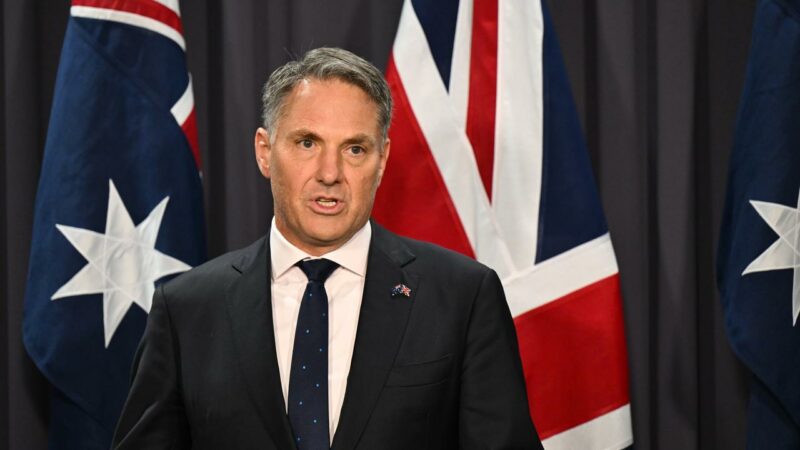Defence Minister Richard Marles rolled out some glossy new brochures this week spelling out the composition of the Australian Defence Force in the decades ahead. As media quibbled about this equipment purchase or that one, former Senator and submariner Rex Patrick explains the sovereignty sell-out hidden in plain sight.
Washington Syndrome
It’s confirmed. All the evidence points to the Defence Minister suffering from Stockholm Syndrome (or more accurately Washington Syndrome), except that he hasn’t just formed a bond with his Defence Department, where he won’t challenge them. He’s swallowed the whole kit and caboodle; adopting Defence lingo and lines as his own.
Marles has expressed Defence’s wishes beautifully, without revealing explicitly what that wish is. But it’s sitting there in plain sight.
National Defence Strategy
The use of smokescreens is a longstanding battlefield tactic, and it’s often employed by bureaucrats too. To get a clear and truthful picture from the National Defence Strategy released this week, you have to peer through a dense cloud of verbiage to get a clear sense of what’s really going on.
Early in the document the strategic framework is laid out.
Our Alliance with the US remains fundamental to Australia’s national security. We will continue to deepen and expand our defence engagement with the US, including by pursuing greater scientific, technological and industrial cooperation, as well as enhancing our own cooperation under force posture initiatives.
So, we’re joined at the hip to the United States, and we intend to stay that way.
The document spells out why Defence thinks we need to do that.
The optimism at the end of the Cold War has been replaced by uncertainty and tension of entrenched and strategic competition between the US and China.
…
It is accompanied by an unprecedented conventional and non-conventional build-up in our region, taking place without strategic reassurance or transparency.
…
This build up is also increasing the risk of military escalation or miscalculation that could lead to a major conflict in the region.
Indeed, it zooms in with on the specifics.
The risk of a crisis in the Taiwan Strait is increasing, as well as other flashpoints, including disputes in the South and East China Seas and on the border with India.
It then lays out how Australia and the US will jointly prepare to face our enemy – China.
The Government will continue to strengthen its defence engagement with the US to:
- ensure joint exercises and capability rotations with the US are focused on enhancing collective deterrence and force posture cooperation.
- Acquire the technology and capability required to enhance deterrence, including through increasing collaboration on defence innovation, science and technology.
- Drive interoperability and interchangeability in the development of the of the ADF’s force structure and enable Australian access to US systems and capabilities, including through technology transfer, information sharing, innovation, co-development, co-production and co-sustainment programs;
- Leverage Australia’s strong partnership with Japan in its trilateral context, including opportunities for Japan to participate in Australia-US force posture cooperation activities, to enable interoperability and contribute to deterrence; and
- Progress enabling reforms to export controls, procurement policy and information sharing to deliver a more integrated industrial base.
Meanwhile, the US is increasing its military footprint in Australia in terms of facilities in the north (mission briefing/intelligence centre and aircraft parking aprons) at RAAF Darwin, fuel storage at Darwin Port, infrastructure at RAAF Tindal near Katherine and logistics storage in both Victoria and Queensland).
This is on top of the long established top secret signals intelligence base, the Joint Defence Facility Pine Gap, and Australian support for US naval communications through the very low-frequency receiving and transmission facility at North West Cap. As far as American strategists are concerned, Australia has long been “a suitable piece of real estate”.
But now there’s a new dimension to the alliance with Australian taxpayers are sharing the alliance love by pouring billions into the US submarine industrial base.
Join our Team! AUKUS foreign expenditure sinkhole blows out to $12B … already
US Seventh and a Half Fleet
Of course, it’s hard to fight a conflict in Taiwan Straights with an army. That’s reflected in the distribution of future expenditure outline in the Integrated Investment Program, released alongside the National Defence Strategy.
The Navy will receive almost 40% of all Defence expenditure. The Royal Australian Navy will become the seventh and a half fleet of the US Navy, supported by what are being referred to as the expeditionary air operations by the Royal Australian Air Force.
Again, hidden in plain sight.
Taiwan
Taiwan is a democracy of 22 million people. I might like to think we would come to their aid in the event their democracy was threatened.
But sending our sons and daughters to engage in a northern hemisphere conflict is a matter which should be decided upon by our Parliament at some future time.
We should seek to have a balanced and flexible Defence Force optimised first for Defence of Australia and second for near regional security (a deployment to Taiwan, if approved by our elected members, should draw from an order-of-battle optimised for Defence of Australia).
Sovereignty Stolen
But that’s not what’s happening.
It’s all too tempting to suggest that the sovereignty sell-out started at with AUKUS, announced by Scott Morrison on 16 September 2021 and adopted by Anthony Albanese at the Kabuki show in San Diego on 15 March 2023. But it didn’t.
For those astute enough to have picked up and read a copy of Professor Clinton Fernandes’ book “Sub-Imperial Power: Australia in the International Arena”, they’ll know AUKUS is just natural and obvious. So too is the even greater embedding of the ADF into the US military to serve the needs of Washington that has been announced this week, albeit without announcement.
The process is almost complete. The Australian Defence Force’s integration into the US military to serve the needs of Washington has been announced, albeit without announcement, this week.
Arguably the only thing left to do is to adopt American spelling and replace the letter ‘c’ with the letter ‘s’ in ‘Department of Defence’.
History repeats
We have been down this road before.
In the 1920s and 1930s conservative Australian Governments saw Australian security as part of that of the British Empire as a whole. As a consequence, they implemented defence programs that were designed to produce forces, especially the Royal Australian Navy, that were hopelessly unbalanced and only made sense as a subset of British forces. Imperial Defence was prioritised ahead of national defence in a ‘strategy’, if you can call it that, that compromised Australia’s then very new national sovereignty and almost came to disaster in 1942.
Now, decades later, Australia’s defence force is being integrated into that of a great and powerful friend as tightly as when we were part of the British Empire. Ironically this is now happening under the party which, when it was led by Labor icon John Curtin, expressed scepticism about imperial defence and urged a focus on defence of Australia.
Bureaucratic and political self-interest
Australia’s new “National Defence Strategy” really is nothing of the sort. It’s a sub-set of strategic planning made in Washington, not an Australian national perspective.
AUKUS has devoured whatever vestiges of independent strategic thought that might have been lingering in our Defence Department.
But don’t imagine that there’s any dissent about this in Defence Headquarters.
Those in Defence bureaucracy guiding our politicians are be happy, uproariously happy, because they’ll personally benefit from the arrangement.
AUKUS and this latest steerage will serve as a tremendous career and institutional opportunity for them. They’ve cemented their position in an alliance arrangement that involves important meetings and conferences, important decisions, trips overseas, and, for some, exchange postings. For them, they’ve got ringside seats and the opportunity to be occasional players in the big league.
Which brings me back to Defence Minister Marles, who can’t really be blamed for the sell-out.
Marles isn’t, and never was, the sort of political figure that could develop much of an understanding of what is going on around him, let alone be the one to lead with strategic vision and agenda forward. He’s too busy learning the lingo, enjoying the photo opportunities, and impressing upon his ‘sub-ordinates’ in Defence Headquarters that he’s not to be referred to as the Defence Minister, but rather as the Deputy Prime Minister. Surely he deserves that courtesy!
Marles Mauled: Rex Patrick demolishes Defence sophistry on AUKUS, submarines, nuclear
Rex Patrick is a former Senator for South Australia and, earlier, a submariner in the armed forces. Best known as an anti-corruption and transparency crusader, Rex is also known as the "Transparency Warrior."


